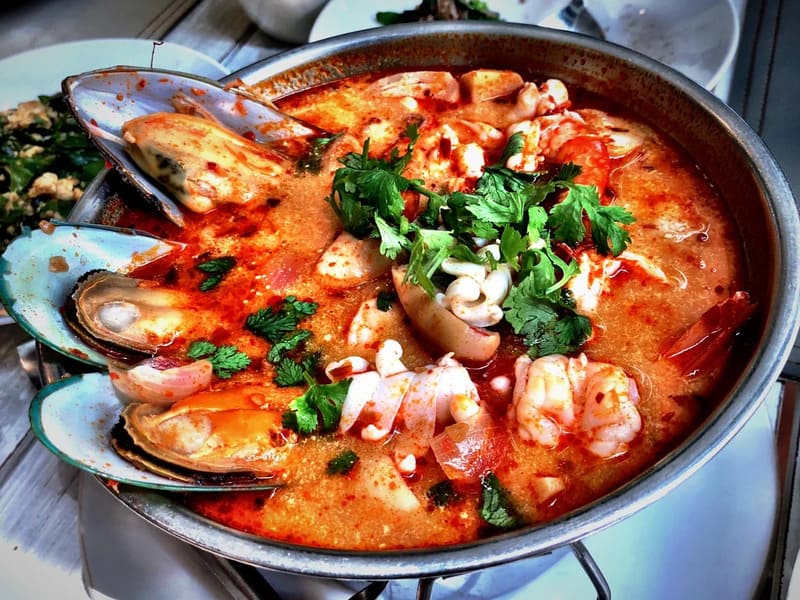Chamberlains of London – Tom Yam is a globally beloved Thai dish known for its perfect balance of spicy, sour, and savory flavors. While the dish is delicious, making a clear and flavorful Tom Yam without a cloudy broth can be a challenge. Here are some tips and a step-by-step guide inspired by a MasterChef to ensure your Tom Yam Seafood is a culinary success.
1. Choosing the Right Ingredients
The key to a great Tom Yam Seafood lies in the quality of its ingredients. Fresh and flavorful components not only enhance the taste but also help in achieving a clear broth.
- Seafood Selection: Use fresh shrimp, squid, and mussels. The seafood should smell fresh and have a firm texture. Frozen options can be used, but they should be thawed and cleaned thoroughly.
- Aromatic Herbs and Spices: Essential ingredients include lemongrass, kaffir lime leaves, galangal, Thai chilies, and shallots. These give Tom Yam its distinctive aroma and taste.
- Flavor Enhancers: Fish sauce, lime juice, and a touch of sugar are crucial for balancing the flavors. Avoid overusing these ingredients, as they can overpower the dish.
- Optional Additions: You can include straw mushrooms or cherry tomatoes for added texture and taste.
By starting with high-quality ingredients, you set the foundation for a delicious and clear Tom Yam.
2. Preparing the Broth for Clarity
A common challenge in making Tom Yam is achieving a clear broth without sacrificing flavor. Here are some techniques to ensure a clean and bright soup base:
- Tidy Preparation: Clean the seafood thoroughly. For shrimp, remove the shells and devein them but reserve the shells for added flavor in the broth.
- Simmer, Don’t Boil: Boiling the broth vigorously can cause the oils from the spices to cloud the soup. Instead, simmer the broth over medium heat.
- Strain the Base: After simmering the aromatic ingredients like lemongrass, galangal, and kaffir lime leaves, strain them out before adding the seafood. This keeps the broth clear while retaining the flavors.
- Timing is Key: Add the seafood only when the broth is ready to ensure they cook perfectly without overcooking and clouding the soup.
These steps ensure that your Tom Yam retains its clear and appetizing appearance.
“Also Read: Cooking Seafood Made Easy: Perfect Timing for Tender and Juicy Results”
3. Perfecting the Flavor Balance
The hallmark of Tom Yam is its harmonious blend of flavors. Achieving this balance requires attention to detail and timing.
- Start with Aromatics: Begin by sautéing shallots, garlic, and Thai chilies in a small amount of oil until fragrant. This step releases their natural oils and enhances the flavor of the broth.
- Layer the Flavors: Gradually add the strained broth, followed by fish sauce and sugar. Allow these flavors to meld together before adding the lime juice at the end to preserve its freshness.
- Adjust to Taste: Taste the broth frequently and adjust the seasoning as needed. The soup should be a balance of sour, spicy, and savory, with a slight sweetness.
Mastering this step ensures that your Tom Yam is bursting with flavor and authenticity.
4. Cooking Seafood to Perfection
Seafood is the star of this dish, and cooking it correctly is crucial to the overall success of your Tom Yam.
- Shrimp: Add the shrimp first as they cook quickly. Once they turn pink and opaque, remove them from the broth to avoid overcooking.
- Squid: Slice the squid into rings and add it towards the end of the cooking process. It only needs about 1-2 minutes to cook.
- Mussels: If using fresh mussels, add them last. Once their shells open, they’re done.
Overcooking seafood can lead to rubbery textures and detract from the dish. Proper timing ensures tender and flavorful seafood in every bite.
Serving and Garnishing Tips
Presentation is just as important as taste. When serving Tom Yam, garnish it with fresh cilantro leaves, thinly sliced chilies, and a wedge of lime on the side. Serve the soup hot with steamed jasmine rice for a complete and satisfying meal.
Additionally, for an extra kick, provide chili oil or flakes on the side for those who prefer a spicier version. These finishing touches elevate the dining experience and make the dish truly memorable.
